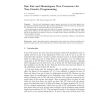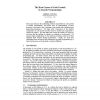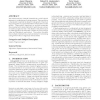50 search results - page 3 / 10 » Quadratic Bloat in Genetic Programming |
GECCO
2005
Springer
13 years 11 months ago
2005
Springer
Resource-Limited Genetic Programming is a bloat control technique that imposes a single limit on the total amount of resources available to the entire population, where resources ...
GPEM
2000
13 years 5 months ago
2000
Abstract. Size fair and homologous crossover genetic operators for tree based genetic programming are described and tested. Both produce considerably reduced increases in program s...
EUROGP
2003
Springer
13 years 11 months ago
2003
Springer
This paper discusses the underlying pressures responsible for code growth in genetic programming, and shows how an understanding of these pressures can be used to use to eliminate...
GECCO
2005
Springer
13 years 11 months ago
2005
Springer
The C-value Paradox is the name given in biology to the wide variance in and often very large amount of DNA in eukaryotic genomes and the poor correlation between DNA length and p...
GECCO
2005
Springer
13 years 11 months ago
2005
Springer
The authors employ multiple crossovers as a novel natural extension to crossovers as a mixing operator. They use this as a framework to explore the ideas of code growth. Empirical...



